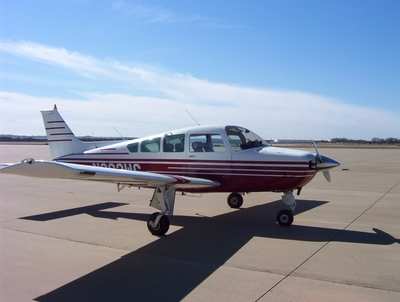Jacksonville (IL) Airport Authority Named For Negligence
The Jacksonville, IL Airport Authority has been named in a lawsuit filed in Circuit Court in Morgan, IL stemming from a December, 2010 accident that resulted in the fatal injury of a passenger aboard a Beech Sierra airplane of a ferry flight.

According to the NTSB's probable cause report, the pilot of the airplane, plot Todd Cole stated that the engine operated normally during the three pretakeoff run-ups that he performed.
The airplane had been operated by Chicago Executive Flight School and had been sold to a private individual in October 2010. The pilot, who was also an airframe and powerplant mechanic, flew into Chicago Executive Airport (PWK), Wheeling, IL, with three other people on the day of the accident to pick up the airplane for a new owner. The pilot and one of the other three people were to fly the accident airplane back to Jacksonville, Illinois, with an en route stop at Schaumburg Regional Airport (06C), Schaumburg, IL. The accident airplane was going to be one of a flight of two airplanes, with the other airplane being the one that the pilot flew in up to PWK.
Cole stated that, after takeoff, the airplane began to sink, and he retracted the flaps at an altitude of about 200 feet above ground level. He turned the airplane back toward the airport, at which time the engine began to vibrate and lose power. The pilot leveled the wings, and the airplane contacted the roof of a building before descending into a parking lot where it struck five cars, and a postimpact fire ensued. Witnesses reported seeing the airplane having difficulty gaining altitude after takeoff. They reported that the airplane was in a nose-high attitude and that the wings were rocking back and forth. They stated that the airplane banked abruptly to the left and descended, that the landing gear remained extended, and that the flaps were retracted. The witnesses who heard the engine stated that it sounded normal during the takeoff.
The engine had been overhauled and the airplane had been flown for 1 hour prior to the accident. The person who flew the airplane at that time stated it operated normally. Although a postaccident examination found foreign debris inside the fuel servo inlet strainer, the debris was most likely a result of the fuel servo being exposed to intense heat during the postimpact fire. All three propeller blades exhibited rotational signatures. Aircraft maintenance records and an inspection of the engine revealed that a low-pressure fuel pump had been installed on the engine during the engine overhaul instead of a high pressure pump. The low-pressure pump likely could not produce enough fuel pressure to sustain engine operation.
The National Transportation Safety Board determined the probable cause(s) of the accident to be the installation of the wrong engine-driven fuel pump, which resulted in a loss of engine power during takeoff, and the pilot's subsequent decision to turn back toward the airport at an insufficient altitude to complete the maneuver. Contributing to the accident was the pilot’s failure to maintain airspeed, which resulted in a loss of aircraft control.

The person fatally injured in the accident was 18-year-old Benjamin VanHyning, who was a passenger on board the airplane. He had been a student Illinois College, and worked at the airport. The Jacksonville, IL Journal-Courier reports that according to court documents, VanHyning's father charges that the Airport Authority was negligent in allowing his son to be aboard the airplane with Cole, who was not a commercial pilot and who had limited experience in the airplane. The suit also charges that the lightly-flown airplane's engine was not running properly after a recent overhaul, and that it should not have been allowed to fly at all. The suit also charges that the airplane, which had been stored outside, had accumulated significant snow and ice, and had not been properly de-iced.
A similar lawsuit was filed by VanHyning's father in 2011, but it was dismissed without prejudice, meaning it could be re-filed.
(Beechcraft Sierra pictured in file photo. Not accident airplane)
 ANN's Daily Aero-Term (05.01.24): Say Altitude
ANN's Daily Aero-Term (05.01.24): Say Altitude ANN's Daily Aero-Linx (05.01.24)
ANN's Daily Aero-Linx (05.01.24) Classic Aero-TV: Korean War Hero Twice Reborn
Classic Aero-TV: Korean War Hero Twice Reborn Airborne 04.29.24: EAA B-25 Rides, Textron 2024, G700 Deliveries
Airborne 04.29.24: EAA B-25 Rides, Textron 2024, G700 Deliveries Airborne Affordable Flyers 05.02.24: Bobby Bailey, SPRG Report Cards, Skydive!
Airborne Affordable Flyers 05.02.24: Bobby Bailey, SPRG Report Cards, Skydive!




